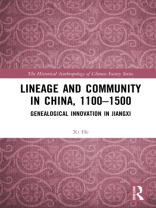Tracing descent from common ancestors was extremely important in imperial China. Members of such lineage communities sacrificed to ancestors in periodic ceremonies, maintained written genealogies to demonstrate their descent, and held some properties in common. This book, based on extensive original research, provides evidence that the practice originated much earlier than previously understood. It shows that in the eleventh century, in southern China under the Song dynasty, the method of compiling a genealogy in the form a table, that is, to say a family tree, replaced its statement as a textual paragraph and that this allowed the tracking of multi-line descent in ways that had previously been impossible. The book also reveals that the practice of recording and presenting genealogical information was not originally unique to communities of common surnames, but that the Southern Song government, keen to encourage loyalty to the state and cohesion within communities, favoured the building of common surname lineages, a practice which then had far-reaching consequences for the nature of Chinese society over a very long period.
Xi He
Lineage and Community in China, 1100–1500 [PDF ebook]
Genealogical Innovation in Jiangxi
Lineage and Community in China, 1100–1500 [PDF ebook]
Genealogical Innovation in Jiangxi
Купите эту электронную книгу и получите еще одну БЕСПЛАТНО!
Формат PDF ● страницы 240 ● ISBN 9781000032185 ● издатель Taylor and Francis ● опубликованный 2020 ● Загружаемые 3 раз ● валюта EUR ● Код товара 7379095 ● Защита от копирования Adobe DRM
Требуется устройство для чтения электронных книг с поддержкой DRM












